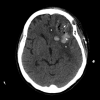Brain Abscesses Caused by Nocardia farcinica in a 44-Year Old Woman with Multiple Myeloma: A Rare Case and Review of the Literature
- PMID: 36266937
- PMCID: PMC9597262
- DOI: 10.12659/AJCR.937952
Brain Abscesses Caused by Nocardia farcinica in a 44-Year Old Woman with Multiple Myeloma: A Rare Case and Review of the Literature
Abstract
BACKGROUND Central nervous system infection by the Nocardia species is associated with high morbidity and mortality. Its occurrence in patients with multiple myeloma is rare and acquisition of the infection in such patients was associated with the use of novel therapeutic agents (eg, bortezomib and lenalidomide) or bone marrow transplantation. Here, we report the first case of Nocardia brain abscesses in a patient with multiple myeloma, without the above risk factors. CASE REPORT A 44-year-old woman with IgG-kappa type multiple myeloma presented with generalized tonic-clonic seizures. Magnetic resonance imaging of the brain revealed 3 space-occupying lesions in left frontal, left parietal, and right parietal regions. Craniotomy and enucleation of the left frontal lesion revealed an abscess. The culture result was Nocardia farcinica. The patient was treated with meropenem, amikacin, and trimethoprim-sulfamethoxazole for 6 weeks, followed by trimethoprim-sulfamethoxazole for 12 months, with good outcome. CONCLUSIONS Cerebral nocardiosis is a rare entity and its occurrence in our case may hint toward myeloma-associated humoral immune dysfunction as a pathogenesis and the importance of humoral immunity in the defense against this infection. However, chemotherapy-induced cell-mediated dysfunction cannot be ruled out as a risk factor for the infection. Despite its rarity, this case aims to raise awareness of the condition and reiterate the importance of considering the rare but life-threatening conditions in the differential diagnosis of brain lesions, especially when there is a misdiagnosis of the radiological findings, as occurred in this and previous cases; this avoids delays in appropriate surgical and medical treatment, which can affect outcomes.
Conflict of interest statement
Figures


Similar articles
-
Disseminated nocardiosis caused by Nocardia farcinica in a patient with colon cancer: A case report and literature review.Medicine (Baltimore). 2021 Jul 23;100(29):e26682. doi: 10.1097/MD.0000000000026682. Medicine (Baltimore). 2021. PMID: 34398037 Free PMC article.
-
Disseminated Nocardia species infection manifested with multiple brain abscesses and lung involvement in an immunocompetent patient: a case report.J Med Case Rep. 2025 Jul 1;19(1):304. doi: 10.1186/s13256-025-05359-z. J Med Case Rep. 2025. PMID: 40598635 Free PMC article.
-
Successful management of Nocardia farcinica brain abscess in an immunocompetent adult with trimethoprim/sulfamethoxazole hypersensitivity: A case report and review.Diagn Microbiol Infect Dis. 2025 Oct;113(2):116954. doi: 10.1016/j.diagmicrobio.2025.116954. Epub 2025 Jun 11. Diagn Microbiol Infect Dis. 2025. PMID: 40543441 Review.
-
Multiple brain abscesses caused by Nocardia farcinica infection after hand injury: A case report and literature review.Medicine (Baltimore). 2024 Jul 19;103(29):e39019. doi: 10.1097/MD.0000000000039019. Medicine (Baltimore). 2024. PMID: 39029015 Free PMC article. Review.
-
Disseminated and cerebral infection due to Nocardia farcinica: diagnosis by blood culture and cure with antibiotics alone.Clin Infect Dis. 1996 Nov;23(5):1165-7. doi: 10.1093/clinids/23.5.1165. Clin Infect Dis. 1996. PMID: 8922819
References
-
- Corti ME, Villafañe-Fioti MF. Nocardiosis: A review. Int J Infect Dis. 2003;7(4):243–50. - PubMed
-
- Pamukçuoğlu M, Emmez H, Tunçcan OG, et al. Brain abscess caused by Nocardia cyriacigeorgica in two patients with multiple myeloma: Novel agents, new spectrum of infections. Hematology. 2014;19(3):158–62. - PubMed
-
- Chouciño C, Goodman SA, Greer JP, et al. Nocardial infections in bone marrow transplant recipients. Clin Infect Dis. 1996;23(5):1012–19. - PubMed
Publication types
MeSH terms
Substances
Supplementary concepts
LinkOut - more resources
Full Text Sources
Medical

